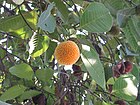Note: This is a project under development. The articles on this wiki are just being initiated and broadly incomplete. You can Help creating new pages.
Anthocephalus cadamba - Kadamba, Wild cinchona
Kadamba scientifically known as Neolamarckia cadamba. It is a large, evergreen tree with beautiful & unique flowers. It is a fast growing tree with a broad crown and is even planted sacredly near temples. This tree is belongs to Rubiaceae family.[1]
Contents
- 1 Uses
- 2 Parts Used
- 3 Chemical Composition
- 4 Common names
- 5 Properties
- 6 Habit
- 7 Identification
- 8 List of Ayurvedic medicine in which the herb is used
- 9 Where to get the saplings
- 10 Mode of Propagation
- 11 How to plant/cultivate
- 12 Season to grow
- 13 Soil type required
- 14 Ecosystem/Climate
- 15 Commonly seen growing in areas
- 16 Photo Gallery
- 17 References
- 18 External Links
Uses
Diabetes, Cancer, Fungal infections, Musculo-skeletal diseases, High cholesterol, Triglycerides, Parasitic infection, Digestive disturbances.
Parts Used
Barks, Flowers, Leaves, Fruits.
Chemical Composition
The preliminary phytochemical screening of Anthocephalus cadamba whole plant showed the presence of saponins, terpenes, sesquiterpenes glycosides, alkaloids and absence of anthraquinones and flavonoids.[2]
Common names
| Language | Common name |
|---|---|
| Kannada | NA |
| Hindi | Kadam, Kadamb |
| Malayalam | Atuthekku, Kadambu, Attutek, Attuttekka |
| Tamil | Kadambu, Kathambu, Kola aiyila, Acokari, Ruttiratcakatampu |
| Telugu | Begada, Kadamba, Kadambakamu, Kadambamu, Kadambe |
| Marathi | Kalamb, Kadam, Kadamb |
| Gujarathi | NA |
| Punjabi | NA |
| Kashmiri | NA |
| Sanskrit | Kadamba, Vrattapuspa, Sisupala |
| English | NA |
Properties
Reference: Dravya - Substance, Rasa - Taste, Guna - Qualities, Veerya - Potency, Vipaka - Post-digesion effect, Karma - Pharmacological activity, Prabhava - Therepeutics.
Dravya
Rasa
Tikta (Bitter), Kashaya (Astringent)
Guna
Veerya
Vipaka
Karma
Prabhava
Habit
Identification
Leaf
| Kind | Shape | Feature |
|---|---|---|
| Simple | Opposite | 10-25 x 6-12 cm, ovate or elliptic-oblong, apex acuminate, base truncate or obtuse, margin entire, glabrous above, pubescent beneath. |
Flower
| Type | Size | Color and composition | Stamen | More information |
|---|---|---|---|---|
| Bisexual | 5-6 x 3-4 mm | Creamish yellow | 5 | Flowers bisexual, yellowish, in globose heads, 2-4.5 cm across. Calyx tube 2-3 mm in diameter, tube globose, lobes 5, 5-6 x 3-4 mm, membranous. |
Fruit
| Type | Size | Mass | Appearance | Seeds | More information |
|---|---|---|---|---|---|
| Capsule | Fruit a capsule on a fleshy globose receptacle, 3.5-5 cm across, orange yellow, capsule membranous; | Seeds many | Flowering and fruiting April to August |
Other features
List of Ayurvedic medicine in which the herb is used
Where to get the saplings
Mode of Propagation
How to plant/cultivate
Seeds are mixed with sand and broadcasted, and the seeds are patted down, taking care not to bury them.[5]
Season to grow
Rainy season
Soil type required
It grows well in deep moist alluvial soils, often along river banks.[6]
Ecosystem/Climate
Anthocephalus cadamba is a typical pioneer species that grows best on deep, moist, alluvial sites, and often in secondary forests along riverbanks and in the transitional zone between swampy, permanently flooded and periodically flooded areas.[7]
Commonly seen growing in areas
Tropical area, Subtropical area.
Photo Gallery
References
- ↑ Karnataka Aushadhiya Sasyagalu By Dr.Maagadi R Gurudeva, Page no:69
- ↑ Chemical composition
- ↑ Morphology
- ↑ Ayurvedic preparations
- ↑ Cultivation
- ↑ Soil type required
- ↑ Climate required
External Links
- Ayurvedic Herbs known to be helpful to treat Diabetes
- Ayurvedic Herbs known to be helpful to treat Cancer
- Ayurvedic Herbs known to be helpful to treat Fungal infections
- Ayurvedic Herbs known to be helpful to treat Musculo-skeletal diseases
- Ayurvedic Herbs known to be helpful to treat High cholesterol
- Ayurvedic Herbs known to be helpful to treat Triglycerides
- Ayurvedic Herbs known to be helpful to treat Parasitic infection
- Ayurvedic Herbs known to be helpful to treat Digestive disturbances
- Herbs with Barks used in medicine
- Herbs with Flowers used in medicine
- Herbs with Leaves used in medicine
- Herbs with Fruits used in medicine
- Herbs with common name in Hindi
- Herbs with common name in Malayalam
- Herbs with common name in Tamil
- Herbs with common name in Telugu
- Herbs with common name in Marathi
- Herbs with common name in Sanskrit
- Habit - Tree
- Index of Plants which can be propagated by Seeds
- Index of Plants which can be propagated by Cuttings
- Herbs that are commonly seen in the region of Tropical area
- Herbs that are commonly seen in the region of Subtropical area
- Herbs
- Ayurvedic herbs that don't have seed photos
- Rubiaceae






